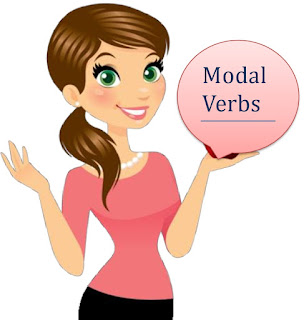Lesson Plan of Modal Verbs Lesson Plan of Modal Verbs
Lesson Plan of Modal Verbs
English Grade V
Students’ Learning Outcomes
·
Illustrate use of can/can’t,
may/mayn’t, and should/ shouldn’t to express permission, prohibition, doubt,
and obligation.
Information for Teachers
·
A modal is a kind of auxiliary (helping) verb that is
used to express: ability, possibility, permission or obligation. Modal phrases
(or semi-modals) are used to express the same things as modals
·
Can, may and should are called modal verbs.
·
Can is used to express ability or to say that
something is possible.
For example: I can speak
English.
·
To form the negative we add
“not” after can to form one word: can’t.
For example: She can’t eat
two burgers.
·
May is used in formal style to request for permission
(in questions) giving permission (in affirmative sentences) and refusing
permission (in negative sentences).
For example: May I borrow
your book for a day? You may have my book.
·
To form negative we add “not”
after may: may not.
·
The verb that comes after can
and may is in the infinite (base form of the verb) without to.
For example: I can bake
cakes. May I sit here?
·
We use should and shouldn’t to give advice, opinions, to talk about what we
think is right or wrong (correctness) to make suggestions, or to talk about
obligation.
·
The negative of should is
shouldn’t.
For example:
o He should exercise every day. (Advice)
o She should wear black sandals with this dress.
(suggestion)
o You shouldn’t write on the wall. (correctness)
o We should respect our elders. (obligation)
·
The verb that comes after
should is in the infinitive (base form of the verb) without to.
·
Time allocation is flexible
and can change as per need of the activity.
Material / Resources
Chalk/markers, board, textbook
Worm up activity
·
Begin the lesson by telling
the students that you have chosen an animal (e.g. monkey) and they have to
guess it. Tell the students that all of them know the animal; some must have
even seen it also. They have to ask questions to guess the animal. Their
question must start with can. Tell the students that you will reply with “yes,
it can”, or “no, it can’t”,
·
Start the game. Continue the
game till students have asked several questions using ‘can’. Provide them with
words if they didn’t know the English words for what they want to say.
·
Students will mostly likely
guess the animal. If they couldn’t guess it within five minutes, you can end
the game by saying that now they must give the name.
·
Ask them to clap for
themselves in the end.
·
Ask the students if they can
now tell when can and can’t are used. They must be able to give correct answer.
If they couldn’t give the answer, tell them that we use can and can’t to tell
whether someone has an ability to do something.
·
Similarly ask students about
‘may’ and ‘mayn’t’.
·
Write a sentence on the board
using ‘should’. E.g. students should speak English in the classroom.
·
Ask the students when is
‘should’ used?
·
Praise the students if they
give correct response.
Development
Activity 1
·
Tell the students to write in
their notebooks five sentences on what they believe they can do.
·
Tell them to write two more
sentences about what they think they can’t do.
·
Explain to the students that
when they write ‘can do’ sentences, they must write the truth. When they write
‘can’t do’ sentences, they should write what they can’t do. E.g. I can’t fly a
plane.
·
Move about in the class to
monitor students and provide help where needed.
Activity 2
·
Tell the students to write in
their notebooks three sentences using ‘may’ and two sentences using ‘may not’.
·
Explain to the students that
when using ‘may’ they are giving permission to do. Something. E.g. you may play
after the class. When using ‘may not’ they are refusing to give permission to
do something. E.g. you may not take my pencil.
·
Provide support where and
when needed while students are doing the work.
Activity 3
·
Write ‘Playground Rules’ on
the board.
·
Tell students to think and
tell some playground rules. They must use ‘should’ and ‘shouldn’t’ in each
rule.
·
Write one rule on the board
for students’ understanding. E.g. playground should be used by students to
play.
·
Write rules on the board as
students give them. Provide students with vocabulary where they needed.
·
Tell the students to write in
their notebooks the ‘playground Rules’.
Sum up / Conclusion
·
Recap the lesson by asking
the students would they be able to use can/can’t, may/mayn’t in the future.
·
Quickly review with the
students the situations in which should/shouldn’t is used.
Assessment
·
Assess students’ ability to
demonstrate use of verb can/can’t, may/mayn’t through their correct responses
during worm up activity.
·
Assess students’ ability to
identify use of can/can’t through the activity 1 and the follow up.
·
Assess students’ ability to
use may/mayn’t for seeking or giving permission/prohibition through the
sentences produced during the activity 2.
·
Assess students’ ability to
demonstrate use of verb should/shouldn’t through their correct responses during
worm up activity.
·
Give students a written test
in which they have to write five classroom rules for behavior.
Follow up
·
Give students five
professions (doctor, teacher, farmer, driver, and mechanic) and tell them to
write five sentences telling what they can do.
·
Tell the students to write
two sentences on what they shouldn’t do so that their house becomes dirty.




Wow! This is really helpful. Thanks
ReplyDeletereally helpful.
ReplyDeleteWorm up activities))
ReplyDeletethank you. really helpful
ReplyDeleteSuggest art integrated activities for modals
ReplyDelete